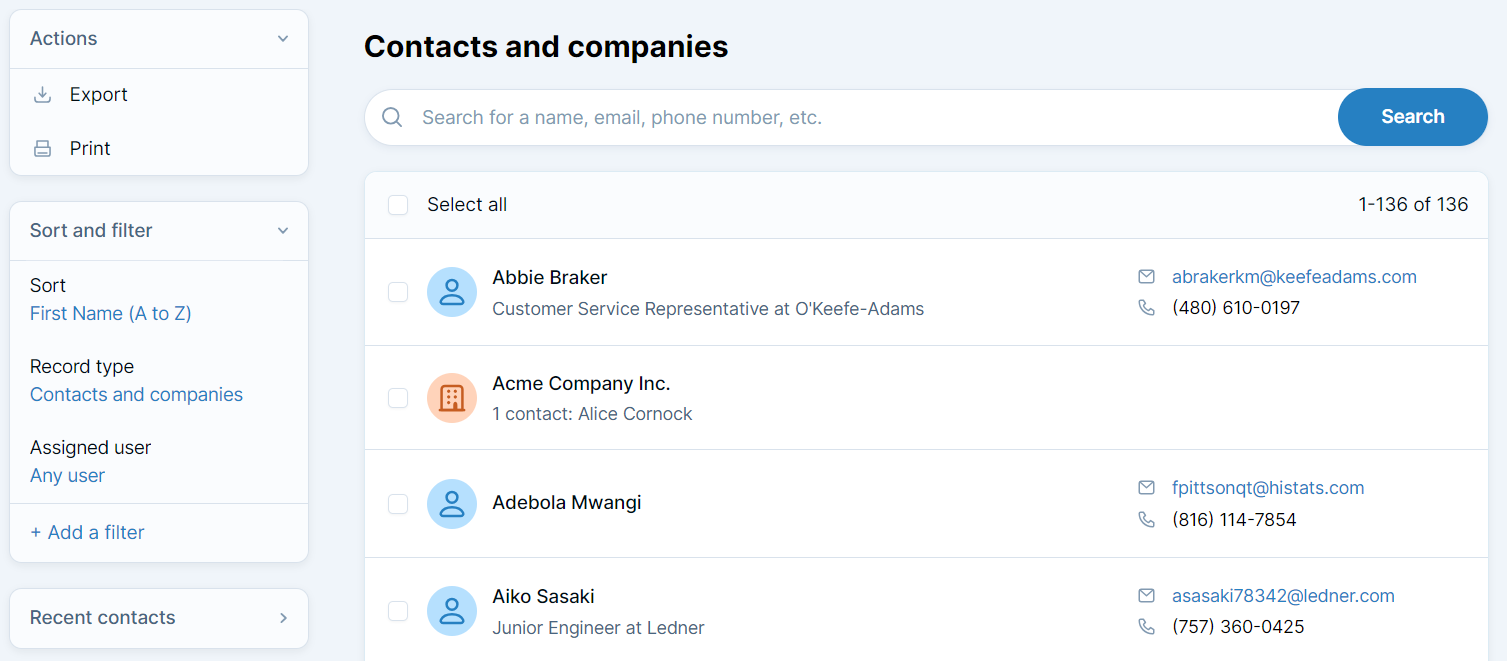An important part of any sales process is following up with potential customers. Follow-ups remind a potential customer you exist, encourage them to talk to you, and those touches eventually turn into sales. Even after a sale it’s important to stay in touch to turn existing customers into recurring customers. If you’re a manager, it’s imperative that you know each team member is following up with their contacts and leads so that nobody slips through the cracks. You can use a filter on the Lead Report to make sure your team is on top of follow-ups for contacts in the sales funnel or the Contacts page to make sure they’re continuing a relationship with existing customers.
The Difference between Contacts and Leads
This tutorial will show you two different ways to view records that haven’t been updated recently. Before we get into that, it’s important to understand the difference between the two approaches and why you might choose one approach over the other.
The first approach will show you updated leads (or other pipelines if you've customized your settings). A lead is only marked as updated if you open the lead pop-up and save an update to that specific lead, like changing a status or priority. Editing the contact (including saving a note on the contact itself) will not update the lead, only editing the lead itself will count as a lead update.
The second approach will show you how to view contacts that haven't been updated in some time. A contact will be marked as updated if anything linked to the contact changes. If you edit a contact’s info, save a note, add them to a group, or anything else like that it will count as an update to the contact.
The difference between these two approaches is where the information is saved, on the contact or on the lead. We generally recommend entering notes along the way within a lead, since that update will be more specific than just seeing anytime a contact was updated.
The difference between contacts and leads can be a bit confusing at first, but it’s pretty simple once you get the hang of it. If you’re not sure you understand contact us and one of our CRM Coaches can walk you through all of this over the phone.
Viewing Leads that have not been updated recently
The Lead Report is available in the menu under the “Reports” tab. The Lead Report lists contacts within the sales funnel, and there are a few different filters to help pull exactly the data you’d like to see, located on the left in the “Sort and filter” section.

(Please note: the term “Lead” is customizable. Lead is the name of a specific pipeline, and your account may show other options in the navigation bar, including “Pipelines”).
- Assigned user -- this filter allows you to view the contacts assigned to a particular user (or users). By default this report shows the contacts for every user you have permission to see, but you can use this filter to see a specific user’s contacts. If you’re a manager checking up on your sales reps, you can use this filter to see only one rep’s contacts, or a team of users’ contacts.
- Add a filter -- click this option to filter your report by any field on the account. Click “Date lead was last updated” to filter by a specific date range. For example, filter by “Date Leads was last updated” and choose “is on or before” and an appropriate time frame to see all leads updated in the last month.
These two filters can be applied together to pull a list of leads that haven’t been touched recently by a rep. Once you have the list, you can print or export the list for meetings or pass it along to your rep to make sure they start making those follow-ups.
Viewing Contacts that have not been updated recently
The Contacts page is accessible through the navigation bar. This page lists all of the contacts that you have access to, whether or not they currently have a lead attached. In the “Sort and filter” section on the left, there are a few filters to find particular contacts. There are two different filters that come in handy for finding contacts that haven’t been updated recently and which team member needs a reminder.

- Assigned user -- this filter allows you to view the contacts assigned to a particular user (or users). By default this report shows the contacts for every user you have permission to see, but you can use this filter to see a specific user’s contacts. If you’re a manager checking up on your sales reps, you can use this filter to see only one rep’s contacts, or a team of users’ contacts.
- Add a filter- click this option to filter your report by any field on the account. Click “Date contact was last updated” to filter by a specific date range. For example, filter by “Date contact was last updated” and choose “is on or before” and an appropriate time frame to see all contacts updated in the last month.
These two filters can be applied together to pull a list of contacts that an individual rep hasn’t followed up with. You can remind your team to check back in with any contacts that have fallen through the cracks, and turn those existing contacts into recurring sales. If someone has really been slacking you can even reassign their contacts to someone else to make sure each contact gets the necessary follow-ups.

Can't find what you're looking for?